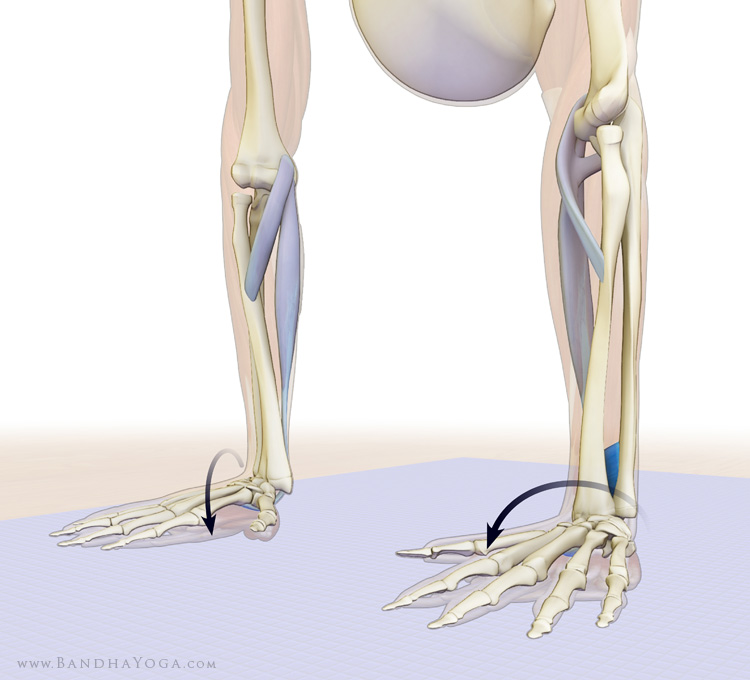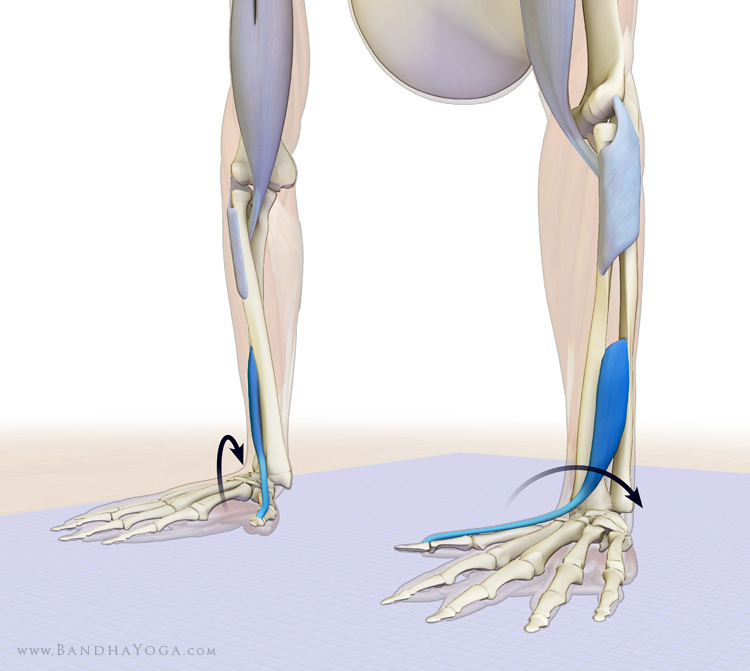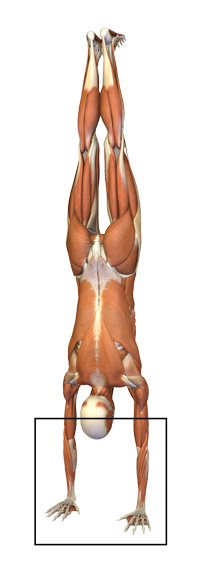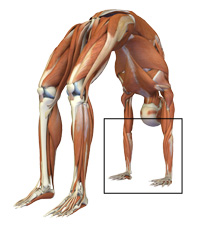
 Full Arm Balance and Urdhva Dhanurasana Explore this first in Dog Pose to get a feel for it. Then, if you are experienced with Full Arm Balance (handstand), try balancing these forces while using a wall for support. Gently press the mounds at the base of the index fingers into the mat and slightly flex the wrists. This engages the muscles that "pronate" the forearms, or turn the palms to face down—the pronators teres and quadratus and the flexor carpi radialis. Then spread the force evenly across the palms to the little finger side of the hands. This engages the muscles that "supinate" the forearms, or turn the palms to face up—the biceps and supinator. Gently attempting to drag the hands towards one another activates the biceps. You can refine supination by extending the thumbs up and away from the mat for a moment and then laying them back down. This engages the extensor pollicis longus.  Feel how these actions balance the energies of the forearms, wrists, and hands. This technique can also be useful in Urdhva Dhanurasana. Always practice poses such as these under the direct guidance of a qualified instructor. If you experience pain in the wrists in either of these poses, come out of the asana. If the pain persists, consult your health care provider. Feel how these actions balance the energies of the forearms, wrists, and hands. This technique can also be useful in Urdhva Dhanurasana. Always practice poses such as these under the direct guidance of a qualified instructor. If you experience pain in the wrists in either of these poses, come out of the asana. If the pain persists, consult your health care provider.
Anatomy for Pronators and Supinators of the Forearm and Wrist: The pronator teres has two heads: the humeral head originates from the medial epicondyle of the humerus and the ulnar head originates from the coronoid process of the ulna. Both heads combine into one tendon that inserts onto the lateral surface of the radius. This muscle acts to pronate the forearm (turn the palm to face down). It can also assist in flexing the elbow. The pronator quadratus originates from the distal quarter of the anterior surface of the ulna and inserts onto the distal quarter of the anterior radius. It acts to pronate the hand and stabilize the wrist. The flexor carpi radialis longus originates from the medial epicondyle of the humerus and runs diagonally across the forearm to insert onto the base of the second metacarpal bone of the hand. It acts to flex the wrist and abduct (radially deviate) the hand and assists in pronating the forearm. The supinator originates from the lateral epicondyle of the humerus, lateral collateral ligament of the elbow, annular ligament of the radio-ulnar joint, and olecranon process of the ulna (see image). It inserts onto the back (dorsum) and lateral surfaces of the upper third of the radius. The supinator acts to supinate the forearm (turn the palm to face up). The extensor pollicis longus originates from the middle part of the posterior surface of the ulna and the interosseous membrane that runs between the radius and ulna. It inserts onto the dorsal surface of the distal phalanx of the thumb. For the biceps anatomy, click here to learn about the anatomy of the biceps muscles. Also, feel free to check out our blog, The Daily Bandha. Namasté, Ray and Chris |
  |